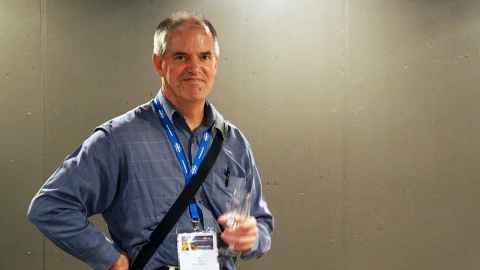Take 10 with... Paul Kilmartin
Professor Paul Kilmartin from the School of Chemical Sciences, gives us 10 minutes of his time to discuss how electrodes can monitor the oxidation and reduction processes of conducting plastics and wine.

1. Describe your research topic to us in 10 words or less.
Electrochemistry meets plastics, wine and biocides.
2. Now explain it in everyday terms!
It may all seem disconnected, but the performance of conducting plastics, and the maturation of red and white wines, are all based upon oxidation and reduction processes that we can monitor using electrodes. And we’ve been able to show that conducting plastics and tannins derived from grape waste exhibit antioxidant and antimicrobial effects that can be employed in active packaging for food products.
3. Describe some of your day-to-day research activities.
The best part of the day is catching up with the research students to see how the latest experiments are progressing or new ideas are being developed. In our new building 302 this includes checking outputs for electrochemical devices, and smelling newly made research wines in the basement – the first building 302 vintage is soon to be bottled!
4. What do you enjoy most about your research?
I’m always on the look-out for an unexpected result, which persists with repeat experiments. Often the students are initially disappointed that experiments are seeming to fail, but our most interesting findings have come from learning from these “mistakes”.
5. Tell us something that has surprised you in the course of your research.
Getting an email on 1 Dec 2009 from Kim Goldwater suggesting that we relocate Wine Science to the Goldie winery on Waiheke Island. This was one example of the great interest leaders within the NZ wine industry have taken in our research and teaching programmes.
6. How have you approached any challenges you’ve faced in your research?
Equipment breakdown, or a loss of trial grapes to weather events, or spending 2-3 years developing assays for aromas in NZ Sauvignon blanc only to get very low levels in our research wines.
7. What questions have emerged as a result?
Why are aromas low in (hand-picked) research wines and so high in commercial NZ Sauvignon blanc? Machine harvesting along with adequate antioxidant protection right at harvest ends up being key to produce that intense Marlborough style of Sauvignon blanc wine.
8. What kind of impact do you hope your research will have?
It’s having that ONE paper from time to time that really gets noticed internationally, leading to invitations for keynote presentations overseas. Also supporting NZ industries through research that addresses their needs and developing opportunities.
9. If you collaborate across the faculty or University, who do you work with and how does it benefit your research?
Many people could be mentioned here, including 5 PhD students I’m currently hosting to run electrochemistry experiments from groups in Engineering and Chemical Sciences. Longer term collaborations include A/P Anthony Phillips in SBS for sensor development for disease diagnostics, and A/P Simon Swift from the Medical School, who jointly co-directs the MBIE Biocide Toolbox programme with myself, and runs the testing of antimicrobial polymers and agents being developed across the University, and at Otago, Scion and the Cawthron.
10. What one piece of advice would you give your younger, less experienced research self?
Write more grant applications. Get out of the office to meet future collaborators in CRIs and industry.